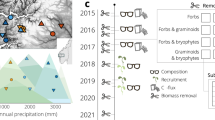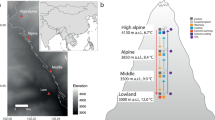Abstract
Despite advances in plant functional ecology that provide a framework for predicting the responses of vegetation to environmental change1,2,3, links between plant functional strategies and elevated temperatures are poorly understood3,4,5. Here, we analyse the response of a species-rich grassland in northern England to two decades of temperature and rainfall manipulations in the context of the functional attributes of 21 coexisting species that represent a large array of resource-use strategies. Three principal traits, including body size (canopy height), tissue investment (leaf construction cost), and seed size, varied independently across species and reflect tradeoffs associated with competitiveness, stress tolerance, and colonization ability. Unlike past studies5,6,7, our results reveal a strong association between functional traits and temperature regime; species favoured by extended growing seasons have taller canopies and faster assimilation rates, which has come at the expense of those species of high tissue investment. This trait-warming association was three times higher in deep soils, suggesting species shifts have been strongly mediated by competition8. In contrast, vegetation shifts from rainfall manipulations have been associated only with tissue investment. Functional shifts towards faster growing species in response to warming may be responsible for a marginal increase in productivity in a system that was assumed to be nutrient-limited9.
This is a preview of subscription content, access via your institution
Access options
Subscribe to this journal
Receive 12 print issues and online access
$209.00 per year
only $17.42 per issue
Buy this article
- Purchase on Springer Link
- Instant access to full article PDF
Prices may be subject to local taxes which are calculated during checkout




Similar content being viewed by others
References
Grime, J. P. et al. Integrated screening validates primary axes of specialisation in plants. Oikos 79, 259–281 (1997).
Lavorel, S. & Garnier, E. Predicting changes in community composition and ecosystem functioning from plant traits: revisting the Holy Grail. Funct. Ecol. 16, 545–556 (2002).
Suding, K. N. et al. Scaling environmental change through the community-level: a trait-based response-and-effect framework for plants. Glob. Change Biol. 14, 1125–1140 (2008).
Westoby, M., Falster, D. S., Moles, A. T., Vesk, P. A. & Wright, I. J. Plant ecological strategies: some leading dimensions of variation between species. Annu. Rev. Ecol. Syst. 33, 125–159 (2002).
Chapin, F. S., Bret-Harte, M. S., Hobbie, S. E. & Zhong, H. Plant functional types as predictors of transient responses of arctic vegetation to global change. J. Veg. Sci. 7, 347–358 (1996).
Reich, P. B., Walters, M. B. & Ellsworth, D. S. From the tropics to tundra: global convergence in plant functioning. Proc. Natl Acad. Sci. USA 94, 13730–13734 (1997).
Ordoñez, J. C. et al. A global study of relationships between leaf traits, climate and soil measures of nutrient fertility. Glob. Ecol. Biogeogr. 18, 137–149 (2009).
Fridley, J. D., Grime, J. P., Askew, A. P., Moser, B. & Stevens, C. J. Soil heterogeneity buffers community response to climate change in species-rich grassland. Glob. Change Biol. 17, 2002–2011 (2011).
Phoenix, G. K. et al. Effects of enhanced nitrogen deposition and phosphorus limitation on nitrogen budgets of semi-natural grasslands. Glob. Change Biol. 9, 1309–1321 (2003).
Chapin, F. S. The mineral nutrition of wild plants. Annu. Rev. Ecol. Syst. 11, 233–260 (1980).
Díaz, S. & Cabido, M. Plant functional types and ecosystem function in relation to global change. J. Veg. Sci. 8, 463–474 (1997).
Grime, J. P. Plant Strategies, Vegetation Processes, and Ecosystem Properties (Wiley, 2006).
Wright, I. J. et al. The worldwide leaf economics spectrum. Nature 428, 821–827 (2004).
Reich, P. B. The world-wide “fast-slow” plant economics spectrum: a traits manifesto. J. Ecol. 102, 275–301 (2014).
Harte, J. & Shaw, R. Shifting dominance within a montane vegetation community: results of a climate-warming experiment. Science 267, 876–880 (1995).
Elmendorf, S. C. et al. Global assessment of experimental climate warming on tundra vegetation: heterogeneity over space and time. Ecol. Lett. 15, 164–175 (2012).
Wright, I. J. et al. Modulation of leaf economic traits and trait relationships by climate. Glob. Ecol. Biogeogr. 14, 411–421 (2005).
Moles, A. T. et al. Which is a better predictor of plant traits: temperature or precipitation? J. Veg. Sci. 25, 1167–1180 (2014).
Grime, J. P. et al. The response of two contrasted grasslands to simulated climate change. Science 289, 762–765 (2000).
Grime, J. P. et al. Long-term resistance to simulated climate change in an infertile grassland. Proc. Natl Acad. Sci. USA 105, 10028–10032 (2008).
Dukes, J. S. et al. Responses of grassland production to single and multiple global environmental changes. PLoS Biol. 3, e319 (2005).
Körner, C. H. Alpine Plant Life: Functional Plant Ecology of High Mountain Ecosystems (Springer, 2003).
Kollas, C., Körner, C. & Randin, C. F. Spring frost and growing season length co-control the cold range limits of broad-leaved trees. J. Biogeogr. 41, 773–783 (2014).
Keenan, T. F. et al. Net carbon uptake has increased through warming-induced changes in temperate forest phenology. Nature Clim. Change 4, 598–604 (2014).
Parmesan, C. Influences of species, latitudes and methodologies on estimates of phenological response to global warming. Glob. Change Biol. 13, 1860–1872 (2007).
Dray, S. et al. Combining the fourth-corner and the RLQ methods for assessing trait responses to environmental variation. Ecology 95, 14–21 (2014).
Funk, J. L. & Cornwell, W. K. Leaf traits within communities: context may affect the mapping of traits to function. Ecology 94, 1893–1897 (2013).
Westoby, M. A leaf-height-seed (LHS) plant ecology strategy scheme. Plant Soil 199, 213–227 (1998).
Rui, Y. et al. Warming and grazing increase mineralization of organic P in an alpine meadow ecosystem of Qinghai-Tibet Plateau, China. Plant Soil 357, 73–87 (2012).
Ravenscroft, C. H., Fridley, J. D. & Grime, J. P. Intraspecific functional differentiation suggests local adaptation to long-term climate change in a calcareous grassland. J. Ecol. 102, 65–73 (2014).
Acknowledgements
The Buxton Climate Change Impacts Laboratory is funded by the US National Science Foundation (DEB 1242529). The authors gratefully acknowledge technical assistance from M. Heberling and manuscript comments of A. Moles.
Author information
Authors and Affiliations
Contributions
J.D.F. and J.P.G. designed the study with input from A.P.A.; A.P.A. and J.P.G. maintained the climate experiment; J.D.F. and J.S.L. conducted the greenhouse trait assays; J.P.G. and J.D.F. performed plot surveys; A.P.A. and J.P.G. performed the biomass survey; and J.D.F. analysed the data and wrote the paper.
Corresponding author
Ethics declarations
Competing interests
The authors declare no competing financial interests.
Supplementary information
Supplementary Information
Supplementary Information (PDF 1249 kb)
Rights and permissions
About this article
Cite this article
Fridley, J., Lynn, J., Grime, J. et al. Longer growing seasons shift grassland vegetation towards more-productive species. Nature Clim Change 6, 865–868 (2016). https://doi.org/10.1038/nclimate3032
Received:
Accepted:
Published:
Issue Date:
DOI: https://doi.org/10.1038/nclimate3032
This article is cited by
-
Simulation of the Ecosystem Productivity Responses to Aerosol Diffuse Radiation Fertilization Effects over the Pan-Arctic during 2001–19
Advances in Atmospheric Sciences (2024)
-
Large herbivores facilitate the persistence of rare taxa under tundra warming
Scientific Reports (2022)
-
Adaptation to chronic drought modifies soil microbial community responses to phytohormones
Communications Biology (2021)
-
Light limitation regulates the response of autumn terrestrial carbon uptake to warming
Nature Climate Change (2020)
-
Estimation of spatial and temporal changes in net primary production based on Carnegie Ames Stanford Approach (CASA) model in semi-arid rangelands of Semirom County, Iran
Journal of Arid Land (2019)



